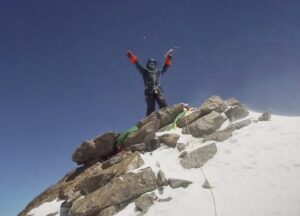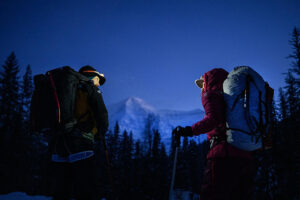Last month, from November 5-7, an experienced Japanese party made an alpine-style attempt on 6,257m Chekigo Peak in Rolwaling, Nepal. It has only been successfully climbed once before. They did not summit but made it up the south face to the main ridge.

Chukyima Go and surrounding peaks. Photo: Michael Wandinger
Hiroyoshi Manome, Yukio Ueda, and Makoto Kuroda’s original plan was to climb Chukyima Go (6,259m), another mountain in the Rolwaling Himal. They planned to ascend the unclimbed south face, then follow the southeast ridge to Chukyima Go. They would then traverse the mountain from south to north, opening up new alpine-style routes.
The expedition had been planned a few years ago, but COVID restrictions delayed their project until this year. However, their plan changed after they arrived. They did not feel sufficiently acclimatized for this longer project. So instead of Chukyima Go, they sought a permit for nearby Chekigo. Their modest acclimatization would cause difficulties on Chekigo as well.
Chekigo
On October 30, Ueda had a fever and had to leave base camp for a few days to recover. Meanwhile, Manome and Kuroda decided to attempt Chekigo by its south face.
On November 1, Manome scouted the route, ascending without gear to save weight. He intended to go up as far as he could. He reached 5,400m, to the edge of a serac. From there, it was too dangerous to proceed without high-altitude boots and crampons. Above him, at around 5,500m, he could see an area that might make a stable bivouac. Then he descended to base camp.

The first wall Manome faced during his reconnaissance climb. Photo: Hiroyoshi Manome

A distant view of the upper face during the reconnaissance. Photo: Hiroyoshi Manome
On November 5, Manome and Kuroda left base camp. They did not carry a tent, hoping that the weather would hold. Just in case, they took a sleeping bag. Slowly but steadily, they climbed up to 5,400m.
They continued up the 80° wall and fixed 55m of rope. At 3:30 pm, they turned back to the bivouac area and spent the night “in a perfect open bivouac on a clear, windless night”.

Just below the seracs on the south face of Chekigo. Photo: Hiroyoshi Manome
When they woke up at 2:45 am, it was very cold and Kuroda was coughing. They drank some tea and started up.
Three hours later, they arrived at Manome’s anchor from the day before. They continued, but Manome realized that he was moving slower than expected.
“After [each] four or five steps, I stopped because of heavy breathing. The main ridgeline never seemed to get closer,” Manome recalled.

The morning of the second day. Photo: Hiroyoshi Manome
Harder to breath
“It took four hours to climb the 300m snow wall, but my legs were tired and I was out of breath,” Manome wrote. Still, they continued up. They could see the seracs below the main ridge.
It was now 12:10 pm. Manome had thought that they would summit that morning, but they were much slower than expected. Doubts crept in. In his later trip report, Manome described his thought process: “Isn’t this tired feeling odd? Should I proceed from here? To be honest, I was thinking [of going back] at this point.”

The dangerous southern slope of Chekigo, in poor visibility. Photo: Hiroyoshi Manome
They decided to continue and eventually reached the main ridge. A harsh, cold wind hit them from the Chinese side of the mountain.
“I couldn’t see the top of Chekigo Peak because of the serac. Melungtse rose in front of us. There were many glacial lakes below. Kuroda came up and I was vaguely thinking that the knife edge on the ridge would be difficult,” Manome said.

The Japanese team’s open bivouac. Photo: Hiroyoshi Manome
Time to give up
When Kuroda reached Manome, they realized that they had to turn back. To top out, they would have to bivouac on the sharp main ridge. This was too risky. They took a five-minute break, then started to descend in dangerous conditions.

Makoto Kuroda on the main ridge on Chekigo. Photo: Hiroyoshi Manome
Visibility was getting worse. The descent was “honestly scary”, they said. As the snow quality was bad, they rappeled where they could. Where rappeling was not possible, they had to be extremely careful. Despite this, Manome almost suffered an accident. Finally, they managed to reach base camp.

Back at base camp. Photo: Yukio Ueda
“It made me think again that it is difficult to smoothly acclimatize to the altitude and to maintain good physical condition,” Manome said. Although they had not summited Chekigo, they felt satisfied because they had worked hard on the mountain.
Strong CVs
Manome, Ueda, and Kuroda’s alpine-style credentials are outstanding.
In 1992, Manome climbed Kusum Kanguru (6,367m) via the north ridge in alpine style with Koji Asano and Atsushi Sakudo.
In October 1994, with climbing partners Hiroshi Oda, Shukoh Sakai, and Masaaki Tomita, Manome climbed Bhagirathi II (6,512m) via the southwest buttress.
In July 1999, Kuroda and Shogo Kada climbed the Bustle Tower in North America’s Logan mountains by a new route. The climb only appeared in the American Alpine Journal two years later.

During the first ascent of Kyashar’s South Pillar. A foreshortened view of the crux snow arete, with the granite headwall and capping seracs visible above. Photo: Hiroyoshi Manome
In 2006, Manome, Yasuhiro Hanatani, Yasushi Okada, and Makoto Kuroda climbed Meru Central (6,310m) by the northeast face. It was just the third ascent of the peak. The climbers had already attempted it in 2004 but had retreated from above 6,000m when Hanatani fell and broke both legs.
After Meru Central, Manome, together with Yasushi Okada, made the long-awaited first ascent of the northeast face of Tengkangpoche (6,487m) in November 2008.
Manome was awarded a Piolet d’Or in 2013 for the first ascent of the south pillar of Kyashar (6,769m) in alpine style, with Tatsuya Aoki and Yasuhiro Hanatani.
In 2017, Manome, Kuroda, and Ueda climbed the east ridge of Peak 5,620m in India’s Himachal Pradesh.
Chekigo’s climbing history
Chekigo lies between the Khumbu and Rolwaling Valleys, near the Gaurishankar Himal massif. The first serious attempt to climb it was in the spring of 1955 when a three-man British team led by Alfred Gregory attempted the northwest ridge.
Alred Gregory, Ted Courtenay, and Nepali Lhakpa Tenzing Sherpa reached 6,180m. They stopped 80m below the summit because a huge crevasse blocked the route.
Chekigo was finally summited on May 15, 2005, by Bruce Normand of the UK and Oliver Von Rotz from Switzerland via the west face. This is the only ascent of the peak registered by The Himalayan Database.
However, The Himalayan Database does show two other attempts before 2022. One of these was in October 2017 by the Spanish Chekigo West Face Expedition, led by renowned alpinist Mikel Zabalza, who frequently climbs in this region. They summited Chekigo’s West Summit (6,121m) via a direct line up the west face.

The opposite side of the main ridge (the Chinese side) with views of Menlungtse (7,181m). Photo: Hiroyoshi Manome
The first ascent of this secondary summit is not clear, but it was certainly climbed from the northeast by Paulo Grobel’s team in 2004, according to Lindsay Griffin in an article published by the American Alpine Club. This may have been the first ascent, as climbing permits for these peaks only began in 2002.
In October 2021, the Women’s Mountaineering Team of the Spanish National Mountaineering Federation attempted to climb Chekigo, led by Marc Subirana. The team included Laia Duaigues, Nieves Gil, and Lucia Guichot, among others. They gave up at 6,003m on Chekigo’s east ridge after opening a new route on the south face. They could not proceed further because of 90kph winds.

The 2017 Spanish route ‘Danebat’, on the west face of Chekigo West (6,190m). Photo: Pablo Ruiz






